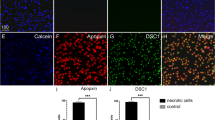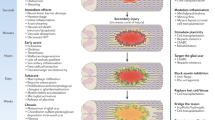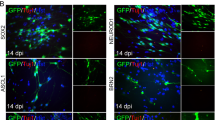Abstract
Restoring function to the injured spinal cord represents one of the most formidable challenges in regenerative medicine. Glial cell transplantation is widely considered to be one of the most promising therapeutic strategies, and several differentiated glial cell types—in particular, Schwann cells and olfactory ensheathing cells (OECs)—have been proposed as transplant candidates. In this Review, we analyze evidence from animal studies for improved functional recovery following transplantation of OECs into spinal cord injuries, and examine the mechanisms by which repair might be achieved. Data obtained using various injury models support the view that OEC transplants can promote functional recovery, but accumulating anatomical evidence indicates that although axons regenerate within a transplant, they do not cross the lesion or reconnect with neurons on the opposite side to any significant extent. Consequently, it is possible that neuroprotection and promotion of sprouting from intact fibers are the main mechanisms that contribute to functional recovery. We conclude that for the foreseeable future the clinical benefits of OEC transplants alone are likely to be modest. The future potential of cell transplantation strategies will probably depend on the success with which the transplants can be combined with other, synergistic, therapies to achieve significant regeneration of axons and re-establish functionally useful connections across a spinal cord injury.
Key Points
-
Olfactory ensheathing cells (OECs) are potential candidates for cell transplantation in CNS repair
-
In some circumstances, OECs appear to promote functional recovery that is detectable using behavioral tests
-
Anatomical evidence suggests that axons can regenerate within a transplant but do not cross a lesion or reconnect with neurons on the opposite side of the lesion
-
The main mechanisms that contribute to functional recovery might be neuroprotection and promotion of sprouting from intact fibers
-
The clinical benefits of OEC transplantation in patients with spinal cord injuries are likely to be modest
This is a preview of subscription content, access via your institution
Access options
Subscribe to this journal
Receive 12 print issues and online access
$209.00 per year
only $17.42 per issue
Buy this article
- Purchase on Springer Link
- Instant access to full article PDF
Prices may be subject to local taxes which are calculated during checkout





Similar content being viewed by others
References
Apparelyzed: Traumatic Spinal Cord Injury Facts & Figures [http://www.apparelyzed.com/statistics.html] (accessed 22 January 2007)
Young W (online 25 June 2006) Spinal Cord Injury Levels & Classification [http://www.sci-info-pages.com/levels.html] (accessed 22 January 2007)
Dimitrijevic MR (1988) Residual motor functions in spinal cord injury. Adv Neurol 47: 139–155
Blight AR (1983) Cellular morphology of chronic spinal cord injury in the cat: analysis of myelinated axons by line-sampling. Neuroscience 10: 521–543
Fehlings MG and Tator CH (1995) The relationships among the severity of spinal cord injury, residual neurological function, axon counts, and counts of retrogradely labeled neurons after experimental spinal cord injury. Exp Neurol 132: 220–228
Bunge RP et al. (1997) Observations on the pathology of several types of human spinal injury with emphasis on the astrocyte response to penetrating injuries. Adv Neurol 72: 305–315
Rhodes KE and Fawcett JW (2004) Chondroitin sulphate proteoglycans: preventing plasticity or protecting the CNS? J Anat 204: 33–48
Silver J and Miller JH (2004) Regeneration beyond the glial scar. Nat Rev Neurosci 5: 146–156
Filbin MT (2003) Myelin-associated inhibitors of axonal regeneration in the adult mammalian CNS. Nat Rev Neurosci 4: 1–11
Dumont RJ et al. (2001) Acute spinal cord injury, part I: pathophysiologic mechanisms. Clin Neuropharmacol 24: 254–264
Reier P (2004) Cellular transplantation strategies for spinal cord injury and translational neurobiology. NeuroRx 1: 424–451
Norenberg MD et al. (2004) The pathology of human spinal cord injury: defining the problems. J Neurotrauma 21: 429–440
Barnett SC and Chang L (2004) Olfactory ensheathing cells: going solo or in need of a friend? Trends Neurosci 27: 54–60
Blesch A et al. (2002) Neurotrophic factors, gene therapy, and neural stem cells for spinal cord repair. Brain Res Bul 57: 833–888
Raisman G (2001) Olfactory ensheathing cells—another miracle cure for spinal cord injury? Nat Rev Neurosci 2: 369–375
Wewetzer K et al. (2002) Olfactory ensheathing glia and Schwann cells: two of a kind? Cell Tissue Res 309: 337–345
Farbman AI (1990) Olfactory neurogenesis: genetic or environmental controls? Trends Neurosci 13: 362–365
Schwob JE (2002) Neural regeneration and the peripheral olfactory system. Anat Rec 269: 33–49
Graziadei PPC (1973) Cell dynamics in the olfactory mucosa. Tissue Cell 5: 113–131
Doucette R (1990) Glial influences on axonal growth in the primary olfactory system. Glia 3: 433–449
Raisman G (1985) Specialized neuroglial arrangement may explain the capacity of vomeronasal axons to reininervate central neurons. Neuroscience 14: 237–254
Barnett SC et al. (1993) Purification of olfactory nerve ensheathing cells from the olfactory bulb. Dev Biol 155: 337–350
Franklin RJ and Barnett SC (2000) Olfactory ensheathing cells and CNS regeneration: the sweet smell of success? Neuron 28: 15–18
Lakatos A et al. (2000) Olfactory ensheathing cells and Schwann cells differ in their in vitro interactions with astrocytes. Glia 32: 214–225
Fairless R and Barnett SC (2005) Cells in focus, olfactory ensheathing cells: their role in CNS repair. Int Biochem Cell Biol 37: 693–699
Barnett SC et al. (2000) Identification of the human olfactory ensheathing cell (OEC) and demonstration of its ability to remyelinate experimentally-induced demyelinating lesions in the rat spinal cord. Brain 123: 1581–1588
Guest J et al. (2003) Rapid recovery of segmental neurological function in a tetraplegic patient following transplantation of fetal olfactory bulb-derived cells. Spinal Cord 44: 135–142
Lima C et al. (2006) Olfactory mucosa autografts in human spinal cord injury: a pilot clinical study. J Spinal Cord Med 29: 191–203
Feron F et al. (2005) Autologous olfactory ensheathing cell transplantation in human spinal cord injury. Brain 128: 2951–2960
Ibrahim A et al. (2006) Olfactory ensheathing cells: ripples of an incoming tide? Lancet Neurol 5: 453–457
Li Y et al. (1997) Repair of adult rat corticospinal tract by transplants of olfactory ensheathing cells. Science 277: 2000–2002
Keyvan-Fouladi N et al. (2005) Delayed repair of corticospinal tract lesions as an assay for the effectiveness of transplantation of Schwann cells. Glia 51: 306–311
Li Y et al. (2003) Transplantation of olfactory ensheathing cells into spinal cord lesions restores breathing and climbing. J Neurosci 23: 727–731
Ruitenberg MJ et al. (2005) NT-3 expression from engineered olfactory ensheathing glia promotes spinal sparing and regeneration. Brain 128: 839–853
Ramón-Cueto A et al. (2000) Functional recovery of paraplegic rats and motor axon regeneration in their spinal cords by olfactory ensheathing glia. Neuron 25: 425–435
Lu J et al. (2001) Transplantation of nasal olfactory tissue promotes partial recovery in paraplegic adult rats. Brain Res 889: 344–357
López-Vales R et al. (2006) Acute and delayed transplantation of olfactory ensheathing cells promote partial recovery after complete transection of the spinal cord. Neurobiol Dis 21: 57–68
Steward O et al. (2006) A re-assessment of the consequences of delayed transplantation of olfactory lamina propria following complete spinal cord transection in rats. Exp Neurol 198: 483–499
Takami T et al. (2002) Schwann cells but not olfactory ensheathing glia transplants improve hindlimb locomotive performance in the moderately contused adult rat thoracic spinal cord. J Neurosci 22: 6670–6681
Plant GW et al. (2003) Delayed transplantation of olfactory ensheathing glia promotes sparing/regeneration of supraspinal axons in the contused adult rat spinal cord. J Neurotrauma 20: 1–16
Polentes J et al. (2004) Phrenic rehabilitation and diaphragm recovery after cervical injury and transplantation of olfactory ensheathing cells. Neurobiol Dis 16: 638–653
Toft A et al. (2006) Electrophysiological evidence for increased synaptic activity in the zone of partial preservation after olfactory ensheathing cell transplants into a spinal cord injury [abstract #762.16]. Presented at Neuroscience 2006: 2006 October 14–18, Atlanta, GA, USA
Lu J et al. (2002) Olfactory ensheathing cells promote locomotor recovery after delayed transplantation into transected spinal cord. Brain 125: 14–21
Li Y et al. (1998) Regeneration of adult rat corticospinal axons induced by transplanted olfactory ensheathing cells. J Neurosci 18: 10514–10524
Nash HH et al. (2002) Ensheathing cells and methylprednisolone promote axonal regeneration and functional recovery in the lesioned adult rat spinal cord. J Neurosci 22: 7111–7120
Imaizumi T et al. (2000) Transplantation of olfactory ensheathing cells or Schwann cells restores rapid and secure conduction across the transected spinal cord. Brain Res 854: 70–78
Lu P et al. (2006) Olfactory ensheathing cells do not exhibit unique migratory or axonal growth-promoting properties after spinal cord injury. J Neurosci 26: 11120–11130
Ruitenberg MJ et al. (2003) Ex vivo adenoviral vector-mediated neurotrophin gene transfer to olfactory ensheathing glia: effects on rubrospinal tract regeneration, lesion size, and functional recovery after implantation in the injured rat spinal cord. J Neurosci 23: 7045–7058
Ramer LM et al. (2004) Peripheral olfactory ensheathing cells reduce scar and cavity formation and promote regeneration after spinal cord injury. J Comp Neurol 473: 1–15
Andrews MR and Stelzner DJ (2004) Modification of the regenerative response of dorsal column axons by olfactory ensheathing cells or peripheral axotomy in adult rat. Exp Neurol 190: 311–327
Riddell JS et al. (2004) Transplants of olfactory ensheathing cells prepared by various methods promote regeneration of ascending dorsal column axons but regeneration is limited to the transplant environment [abstract #619.20]. Presented at Society for Neuroscience 34th Annual Meeting: 2004 October 23–27, San Diego, CA, USA
Riddell JS et al. (2004) Olfactory ensheathing cell grafts have minimal influence on regeneration at the dorsal root entry zone following rhizotomy. Glia 47: 150–167
Li Y et al. (2004) Interaction of transplanted olfactory-ensheathing cells and host astrocytic processes provides a bridge for axons to regenerate across the dorsal root entry zone. Exp Neurol 188: 300–308
Lu P et al. (2004) Combinatorial therapy with neurotrophins and cAMP promotes axonal regeneration beyond sites of spinal cord injury. J Neurosci 24: 6402–6409
Wall JT et al. (1986) Functional reorganization in somatosensory cortical areas 3b and 1 of adult monkeys after median nerve repair: possible relationships to sensory recovery in humans. J Neurosci 6: 218–233
Lundborg G (2005) Nerve Injury and Repair: Regeneration, Reconstruction and Cortical Remodeling, edn 2. Philadelphia: Elsevier, Churchill Livingstone
Humphry DR et al. (2006) Brain reorganization continues for 25 years after spinal injury: changing patterns of activation in human cerebral cortex during attempts to move [abstract #88.9]. Presented at Neuroscience 2006: 2006 October 14–18, Atlanta, GA, USA
Wolpaw JR and Tennissen AM (2001) Activity-dependent spinal cord plasticity in health and disease. Annu Rev Neurosci 24: 807–843
Bunge RP et al. (1993) Observations on the pathology of human spinal cord injury: a review and classification of 22 new cases with details from a case of chronic cord compression with extensive demyelination. Adv Neurol 59: 75–89
Field PM et al. (2003) Ensheathment of olfactory nerves in the adult rat. J Neurocytol 32: 317–324
Franklin RJ et al. (1996) Schwann cell-like myelination following transplantation of an olfactory bulb-ensheathing cell line into areas of demyelination in the adult CNS. Glia 17: 217–224
Sasaki M et al. (2004) Identified olfactory ensheathing cells transplanted into the transected dorsal funiculus bridge the lesion and form myelin. J Neurosci 24: 8485–8493
Sasaki M et al. (2006) Protection of corticospinal tract neurons after dorsal spinal cord transection and engraftment of olfactory ensheathing cells. Glia 53: 352–359
Rizek PN and Kawaja MD (2006) Cultures of rat olfactory ensheathing cells are contaminated with Schwann cells. Neuroreport 17: 459–462
Lakatos A et al. (2000) Olfactory ensheathing cells and Schwann cells differ in their in vitro interactions with astrocytes. Glia 32: 214–225
Fairless R et al. (2005) N-cadherin differentially determines Schwann cell and olfactory ensheathing cell adhesion and migration upon contact with astrocytes. Mol Cell Neurosci 28: 253–263
Ibanez C et al. (2007) Calponin is expressed by fibroblasts and meningeal cells but not olfactory ensheathing cells in the adult peripheral olfactory system. Glia 55: 144–151
Blight AR and Young W (1989) Central axons in injured cat spinal cord recover electrophysiological function following remyelination by Schwann cells. J Neurol Sci 91: 15–34
Woodhall E et al. (2001) Cultured olfactory ensheathing cells express nerve growth factor, brain-derived neurotrophic factor, glia cell line-derived neurotrophic factor and their receptors. Brain Res Mol Brain Res 88: 203–213
Lipson AC et al. (2003) Neurotrophic properties of olfactory ensheathing glia. Exp Neuro 180: 167–171
Au E and Roskams AJ (2003) Olfactory ensheathing cells of the lamina propria in vivo and in vitro. Glia 41: 224–236
Chuah MI et al. (2004) Olfactory ensheathing cells promote collateral axonal branching in the injured adult rat spinal cord. Exp Neurol 185: 15–25
López-Vales R et al. (2004) Increased expression of cyclo-oxygenase 2 and vascular endothelial growth factor in lesioned spinal cord by transplanted olfactory ensheathing cells. J Neurotrauma 2: 1031–1043
Pearse DD et al. (2004) Transplantation of Schwann cells and olfactory ensheathing glia after spinal cord injury: does pretreatment with methylpredisolone and interleukin-10 enhance recovery? J Neurotrauma 21: 1223–1239
Acknowledgements
Work in the authors' laboratories is funded by the Multiple Sclerosis Society of Great Britain and Northern Ireland, the Wellcome Trust, the Medical Research Council and the International Spinal Research Trust. SC Barnett is a Multiple Sclerosis Society Senior Research Fellow.
Author information
Authors and Affiliations
Corresponding authors
Ethics declarations
Competing interests
The authors declare no competing financial interests.
Rights and permissions
About this article
Cite this article
Barnett, S., Riddell, J. Olfactory ensheathing cell transplantation as a strategy for spinal cord repair—what can it achieve?. Nat Rev Neurol 3, 152–161 (2007). https://doi.org/10.1038/ncpneuro0447
Received:
Accepted:
Issue Date:
DOI: https://doi.org/10.1038/ncpneuro0447
This article is cited by
-
Antimicrobial responses of peripheral and central nervous system glia against Staphylococcus aureus
Scientific Reports (2021)
-
Multi-target approaches to CNS repair: olfactory mucosa-derived cells and heparan sulfates
Nature Reviews Neurology (2020)
-
Bioprocessing strategies to enhance the challenging isolation of neuro-regenerative cells from olfactory mucosa
Scientific Reports (2018)
-
Preparation of Human Olfactory Ensheathing Cells for the Therapy of Spinal Cord Injuries
Bulletin of Experimental Biology and Medicine (2018)
-
Common olfactory ensheathing glial markers in the developing human olfactory system
Brain Structure and Function (2017)



